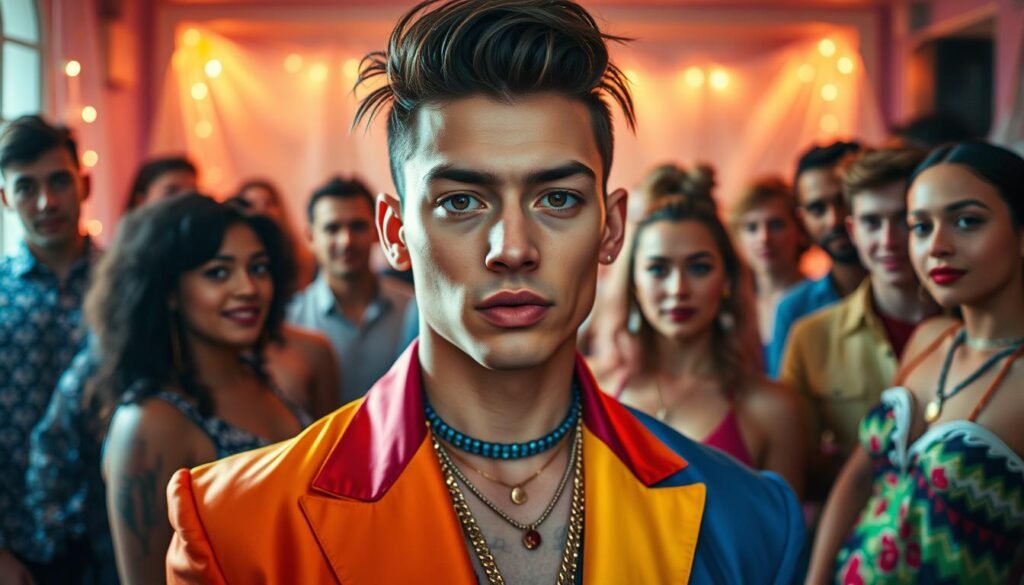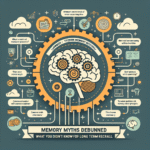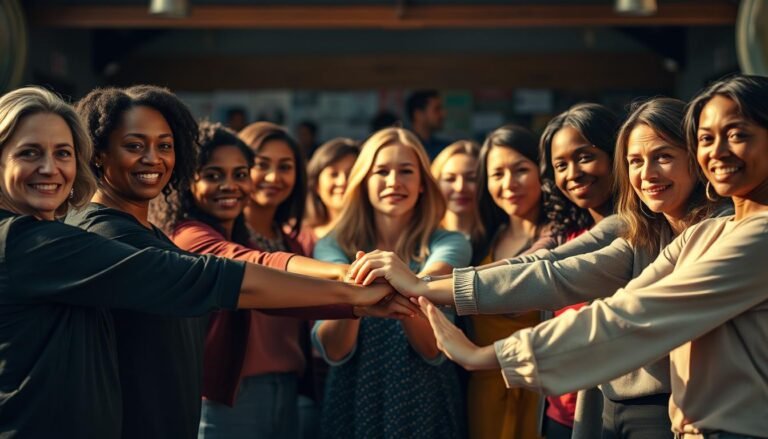
Is wearing clothes meant for the opposite gender just about fashion or sex? Cross-dressing has been around for centuries. It’s used for self-expression, comfort, and fun.
People have worn clothes meant for the opposite gender for many reasons. This shows that gender expression isn’t just about sex. It’s seen in many cultures, showing its depth and complexity.
Looking into cross-dressing, we see it’s more than just a simple act. It has many psychological motivations and cultural meanings. It goes beyond simple labels.
Key Takeaways
- Cross-dressing is a complex phenomenon with historical and cultural roots.
- It serves as a means of self-expression and personal identity.
- The practice challenges traditional notions of gender roles.
- Psychological motivations behind cross-dressing are diverse.
- Cultural significance of cross-dressing varies across different societies.
1. Introduction to the Psychology of Cross-Dressing
Looking into the psychology of cross-dressing means knowing its history and why people do it. For centuries, wearing clothes of the opposite gender has been part of our culture. It’s not just about sex, but also for acting and making life easier.
Defining Cross-Dressing
Cross-dressing is when someone wears clothes meant for the other gender. It happens in shows and as a way to express oneself. The psychology behind cross-dressing is complex, touching on identity, self-expression, and how we interact with others.
Historical Context of Cross-Dressing
Cross-dressing has been seen in many cultures, for many reasons. In ancient times, it was part of religious rituals and social statements. It showed different sides of human culture and society.
| Culture | Historical Period | Context of Cross-Dressing |
|---|---|---|
| Ancient Greece | 5th century BCE | Theatrical performances |
| Native American | Pre-Columbian | Spiritual and ceremonial contexts |
| Japanese | Edo period (1603-1868) | Theater, specially Kabuki |
The history of cross-dressing shows its many meanings and uses. Knowing this history helps us understand its role today.
2. The Cultural Significance of Cross-Dressing
Throughout history, cross-dressing has been a big part of many cultures. It shows how societies view gender and identity. It has been seen in many ways, like in spiritual, theatrical, social, and political settings.
Cross-Dressing in Different Societies
In many cultures, cross-dressing is linked to spiritual or religious practices. For example, some Native American tribes have “Two-Spirits.” These individuals have both masculine and feminine qualities and are highly respected. In some African cultures, cross-dressing is used in rituals to talk to the divine or to be like ancestral spirits.
The theatrical use of cross-dressing is also important. In traditional Japanese theater, male actors play female roles. This shows their skill and the idea that gender can be fluid in performance arts.
Modern Perspectives on Cross-Dressing
In today’s world, cross-dressing is changing, showing new views on gender and identity. Modern views see cross-dressing as a way to challenge old gender norms and support gender fluidity. As Judith Butler says in “Gender Trouble,” cross-dressing can upset how we see gender.
“Gender is a kind of imitation for which there is no original; in fact, it is a kind of imitation that produces the very notion of the original as an effect and a consequence of the imitation itself.” – Judith Butler
Now, cross-dressing is seen as a way to express oneself and find identity in many cultures and media. Seeing more cross-dressers and transgender people in media helps us understand and accept different gender expressions.
As we explore gender identity and expression, understanding cross-dressing’s cultural importance is key. Looking at how it’s seen in different societies helps us appreciate the many ways gender is made and shown.
3. Understanding Gender Identity and Expression
Gender identity is about how a person sees themselves inside. It’s not just about being male or female, but also about feeling like something else. This idea is key to understanding gender expression and its effects on us and society.
Distinction Between Gender Identity and Sexual Orientation
It’s important to know the difference between gender identity and sexual orientation. Gender identity is about who you feel you are, like male, female, or another gender. Sexual orientation is about who you are attracted to, like men or women. These are two different parts of who we are.
For example, being a man or a woman doesn’t mean you’re only attracted to men or women. This shows how complex our identities are. We need to understand these differences to talk about gender and sexuality in a deep way.
The Role of Gender Fluidity
Gender fluidity says that gender isn’t always the same. It can change over time. This idea is important for understanding how people express their gender, like through cross-dressing.
Gender fluidity lets people show their gender in different ways. It depends on their mood, the situation, or how they feel about themselves. It shows that gender is more like a range than just two options, making it easier to accept different gender identities and expressions.
By accepting gender fluidity, we can make a society that values everyone’s uniqueness. We can learn to see gender in a way that goes beyond old norms.
4. Psychological Motivations Behind Cross-Dressing
Exploring the reasons behind cross-dressing helps us understand its emotional benefits and coping strategies. This knowledge is key to creating a supportive space for those who cross-dress.
Emotional Benefits for Cross-Dressers
People who cross-dress often feel less stressed and more confident. They find comfort and a way to express themselves through cross-dressing.
- Enhanced self-confidence
- Reduced anxiety and stress
- A greater sense of personal identity
Cross-dressing can be a therapeutic outlet. It helps individuals deal with complex emotions and experiences. The emotional gains from cross-dressing can greatly improve a person’s overall well-being.
Coping Mechanisms and Therapy
Supporting individuals who cross-dress involves understanding their coping strategies and therapy. Therapy offers a safe place to explore identity and tackle emotional challenges.
Effective coping mechanisms include:
- Joining support groups to connect with others
- Seeking professional therapy for emotional needs
- Creating personal strategies for stress and anxiety management
By supporting these coping mechanisms, we can foster a more inclusive society. A society that accepts all, no matter their gender expression.
5. The Connection Between Cross-Dressing and Self-Expression
Looking into the link between cross-dressing and self-expression shows us how people use fashion to share who they are. Cross-dressing is more than just changing clothes. It’s a way to show one’s true self through what they wear.
Artistic Expression and Cross-Dressing
Artistic expression is key in cross-dressing. It lets people show different sides of themselves and their creativity. By cross-dressing, they can try out new styles and challenge what’s expected of them.
Key aspects of artistic expression in cross-dressing include:
- Exploring different gender roles and identities
- Experimenting with various styles and aesthetics
- Using fashion as a means of creative expression

Fashion as a Medium of Identity
Fashion is a strong way for people to show who they are, including their gender. Cross-dressing lets people use fashion to share parts of themselves that might not be clear through traditional roles. It’s a way to freely explore identity without being tied down by society’s rules.
The link between fashion and identity is deep. It involves:
- The use of clothing and accessories to signal identity
- The exploration of different gender expressions through fashion
- The creation of a personal aesthetic that reflects one’s inner self
In summary, the bond between cross-dressing and self-expression is deep. It gives people a way to explore, express, and share their identity in a complex and varied manner.
6. Myths and Misconceptions About Cross-Dressing
Many people misunderstand cross-dressing because they lack knowledge. This misunderstanding leads to stereotypes that are not true. These stereotypes harm our understanding of gender expression.
Common Stereotypes Debunked
One big myth is that cross-dressing is all about sex. But studies show it’s not just about sex. It’s a way for people to express their gender or explore themselves.
Another myth is that cross-dressing is a mental illness. But the Diagnostic and Statistical Manual of Mental Disorders (DSM-5) says it’s different. It’s not a sickness for everyone who cross-dresses.
Key facts that debunk common stereotypes:
- Cross-dressing is not inherently sexual or fetishistic.
- It is not a mental illness, though some cross-dressers may face mental health challenges.
- Cross-dressing encompasses a wide range of motivations and identities.
The Reality of Cross-Dressing Experiences
For many, cross-dressing is a way to be true to themselves. It can be a comfort, a way to express oneself, or to challenge gender norms.
People cross-dress for different reasons. Some do it often, others rarely. It can be about exploring gender or just enjoying different clothes.
To truly understand cross-dressing, we must see its diversity. By moving past stereotypes, we can create a more welcoming place for everyone.
7. Cross-Dressing in Media and Popular Culture
Media has a big role in how we see gender identity. It shapes our views through films, TV, books, and music. Seeing cross-dressing in these places is key to understanding it better.
Representation in Film and Television
Films and TV shows have made cross-dressing and gender issues more talked about. Characters who dress differently or are transgender are now more common. Shows like “RuPaul’s Drag Race” and movies like “The Birdcage” teach us about gender.
These stories make cross-dressing seem normal and human. They challenge old ideas and help us see gender in a new light. Media shows us that cross-dressing is just a part of being human.
Impact of Media on Public Perception
Media’s effect on how we see cross-dressing is huge. What we see can change how we think. Good or bad, media shapes our views.
It’s important for media to show cross-dressing in a true and varied way. This helps us accept and understand it better. Media can help make society more open and less judgmental.
8. The Role of Community and Support Networks
For cross-dressers, finding community support is key. It helps them understand and express their gender identity. Having friends who get it can make a big difference.
Finding Acceptance in Cross-Dressing Communities
Cross-dressing communities are a safe space for people to share their stories. They offer acceptance and support, easing feelings of loneliness and confusion.
These communities let people explore their gender in a safe place. They can join online forums, attend local groups, or go to social events.
Online Platforms and Support Groups
The internet has made it easier for cross-dressers to find support. Online forums and social media groups are great for connecting and sharing experiences. They offer a safe space to talk and get advice.
Online support groups have many benefits:
- They’re easy to access from anywhere with internet.
- They offer anonymity for those who want it.
- They bring together a wide range of experiences and views.
Here’s a comparison of online and offline support networks:
| Characteristics | Online Support Networks | Offline Support Networks |
|---|---|---|
| Accessibility | Global, accessible from anywhere | Limited to geographical location |
| Anonymity | Possible to remain anonymous | Face-to-face interaction |
| Diversity | Wide range of perspectives | Limited by local community |
Both online and offline support networks are important for cross-dressers. They offer acceptance and support. Using these resources helps individuals feel more confident and understood on their journey.
9. Challenges Faced by Cross-Dressers
People who cross-dress face many obstacles. These include social stigma and mental health issues. These problems can deeply affect their well-being and life quality.
Social Stigmas and Discrimination
Cross-dressers often face social stigmas and discrimination. Societal norms can lead to prejudice and marginalization. For example, a study showed that those who don’t fit traditional gender norms face social exclusion and discrimination in work and school.
Key areas where discrimination occurs include:
- Workplace discrimination, where cross-dressers may face harassment or unfair treatment.
- Social exclusion, where individuals are ostracized by family, friends, or community.
- Legal discrimination, where laws and policies fail to protect the rights of cross-dressers.
A cross-dressing advocate said, “The struggle is not just about being accepted for who you are, but also about being recognized as a legitimate member of society.”
“The most courageous act is to think for yourself. Aloud.” – Coco Chanel
Mental Health Concerns
The mental health implications for cross-dressers can be severe. The stress of living in a society that doesn’t understand can lead to anxiety, depression, and other issues.
The emotional toll can be significant, with many cross-dressers feeling isolated and having low self-esteem. But, with the right support, like therapy and support groups, many can manage these challenges and live fulfilling lives.
Some of the mental health concerns include:
- Anxiety and depression due to social stigma and discrimination.
- Identity issues stemming from societal pressure to conform.
- Trauma resulting from harassment or violence.
To address these challenges, we need a broad approach. This includes education, advocacy, and support. By promoting understanding and acceptance, we can create a more inclusive society for cross-dressers and all gender expressions.
10. The Intersection of Cross-Dressing and LGBTQ+ Identity
Cross-dressing and LGBTQ+ identity are complex topics. They are not just about one thing, but many. Cross-dressing is part of the LGBTQ+ spectrum, touching on different identities and expressions.

Cross-Dressing Within the LGBTQ+ Spectrum
Cross-dressing in the LGBTQ+ community is diverse. People from different identities, like lesbian, gay, bisexual, and transgender, may cross-dress. They do it for self-expression, to explore gender, or to challenge norms.
It’s important to understand the diversity in the LGBTQ+ community. Cross-dressing means different things to different people. For some, it’s a big part of who they are. For others, it’s something they do sometimes.
Advocacy and Representation Efforts
Advocacy and representation are key for LGBTQ+ individuals who cross-dress. They help fight stereotypes and make the community more inclusive. They also make sure cross-dressers’ needs are heard.
Organizations and community groups are very important. They offer support, resources, and a sense of belonging. They also work to change policies and gain acceptance for the LGBTQ+ community.
- Promoting visibility and awareness through events and campaigns
- Providing support and resources for individuals who cross-dress
- Advocating for policy changes to protect the rights of LGBTQ+ individuals
Looking at cross-dressing and LGBTQ+ identity helps us understand more. It shows us why we need to keep fighting for advocacy and representation.
11. Cross-Dressing and Relationships
Cross-dressing can deeply affect personal relationships, changing how we see identity and closeness. As people explore their gender, their relationships can change a lot.
Navigating Romantic Relationships
Romantic relationships with cross-dressing can be tricky. They need a lot of understanding and acceptance from both sides. Open communication is key, letting both feel and share their needs and limits.
It’s important for partners to learn about cross-dressing. This helps clear up any wrong ideas and creates a supportive space.
Trust and empathy are key in these relationships. Partners must work to understand each other, respecting each other’s identities. They should talk about cross-dressing boundaries, both in private and public.
The Impact on Family Dynamics
Cross-dressing can also change family dynamics, leading to different reactions from family members. Supportive family environments are essential for those who cross-dress, giving them a safe place to be themselves.
Family members might need help understanding cross-dressing. They can learn by looking for resources and support groups together. This helps create a loving and accepting family atmosphere.
Dealing with cross-dressing’s impact on family life takes patience and understanding. It’s all about keeping communication open and loving.
12. Therapeutic Approaches to Understanding Cross-Dressing
Therapy can help us understand cross-dressing better. It looks at the psychological and emotional sides of this behavior. This way, people can better handle their experiences.
Talk Therapy and Counseling
Talk therapy and counseling are key in understanding cross-dressing. They offer a safe space to talk about feelings and reasons. Talk therapy helps find out why someone cross-dresses and deals with related emotional issues.
The good things about talk therapy for cross-dressers are:
- It helps understand the emotional benefits of cross-dressing.
- It tackles mental health issues linked to cross-dressing.
- It teaches ways to deal with society’s pressure and stigma.
Group Therapy for Support
Group therapy adds more support for cross-dressers. It brings together people who go through similar things. Group therapy sessions help feel less alone and more understood.
The benefits of group therapy are:
| Benefits | Description |
|---|---|
| Shared Experiences | People share their stories, creating a supportive group. |
| Coping Strategies | Members learn from each other, finding effective ways to cope. |
| Community Building | It builds a community among those who join. |
In summary, therapy, like talk therapy and group therapy, is very important. They help people who cross-dress by providing a safe place to talk and learn. This way, they can understand themselves better and find ways to cope.
13. Legal and Social Rights of Cross-Dressers
It’s important to know the legal rights of cross-dressers to support them. Their rights are tied to LGBTQ+ rights. We need to look at anti-discrimination laws and policies that affect them.
Understanding Anti-Discrimination Laws
Anti-discrimination laws protect cross-dressers. These laws differ by place but aim to stop gender-based discrimination. Legal recognition is key for cross-dressers’ daily lives.
Laws against job, housing, and public place discrimination are vital. The Equality Act aims to add gender identity and expression to these laws. This would help LGBTQ+ people, including cross-dressers, a lot.
Policies Impacting the LGBTQ+ Community
LGBTQ+ policies cover many areas, like healthcare and education. For cross-dressers, these policies greatly affect their well-being and acceptance.
- Healthcare policies that include gender-affirming care are key for cross-dressers’ health.
- Education policies that support gender diversity help reduce bullying against cross-dressers.
- Employment policies that protect against gender identity or expression discrimination are important for cross-dressers’ jobs.
Many groups fight for LGBTQ+ rights, including cross-dressers. By supporting these efforts, we can make society more inclusive and fair.
14. Personal Stories and Experiences
Cross-dressers and their allies share their stories, creating empathy and understanding. These stories give us a peek into their lives, showing both challenges and triumphs. They highlight the journey of self-discovery and acceptance.
Testimonials from Cross-Dressers
Cross-dressers open up about their lives, revealing the importance of self-expression. For them, it’s about aligning their inner self with their appearance. This leads to a more genuine life.
“Cross-dressing has allowed me to express a part of myself that I couldn’t before,” says Jamie, a cross-dresser. “It’s not just about clothes; it’s about feeling true to myself.”
Insights from Allies and Supporters
Allies and supporters are key in the cross-dressing community. They offer acceptance and understanding. Their stories show the value of a supportive environment.
“Supporting my friend who is a cross-dresser has taught me so much about empathy and understanding. It’s shown me that love and acceptance can make a huge difference in someone’s life.”
Here’s a look at the diversity in cross-dressing experiences:
| Aspect | Cross-Dressers’ Experiences | Allies’ and Supporters’ Roles |
|---|---|---|
| Emotional Support | Finding comfort in expressing their gender identity | Providing a safe and non-judgmental space |
| Social Challenges | Dealing with societal stigma and discrimination | Advocating for understanding and acceptance |
| Personal Growth | Developing a stronger sense of self through cross-dressing | Learning from cross-dressers and growing as individuals |
The stories of cross-dressers and their allies show the depth and richness of their experiences. These narratives educate and promote understanding and acceptance of gender diversity.
15. Conclusion: Embracing Diversity in Gender Expression
Looking at cross-dressing and gender identity shows us the importance of diversity. This is key for a society that welcomes everyone. Our talks have shown how complex cross-dressing is, from its psychological roots to its role in media.
Promoting Acceptance
Acceptance is vital for a world where people can express themselves freely. By seeing cross-dressing as a valid way to express oneself, we can fight against social stigmas. This leads to a more inclusive culture.
Looking to the Future
Looking ahead, we must keep working to understand and accept cross-dressing and gender diversity. This means education, advocacy, and support for cross-dressers. By doing this, we aim for a society that values all kinds of diversity.

















